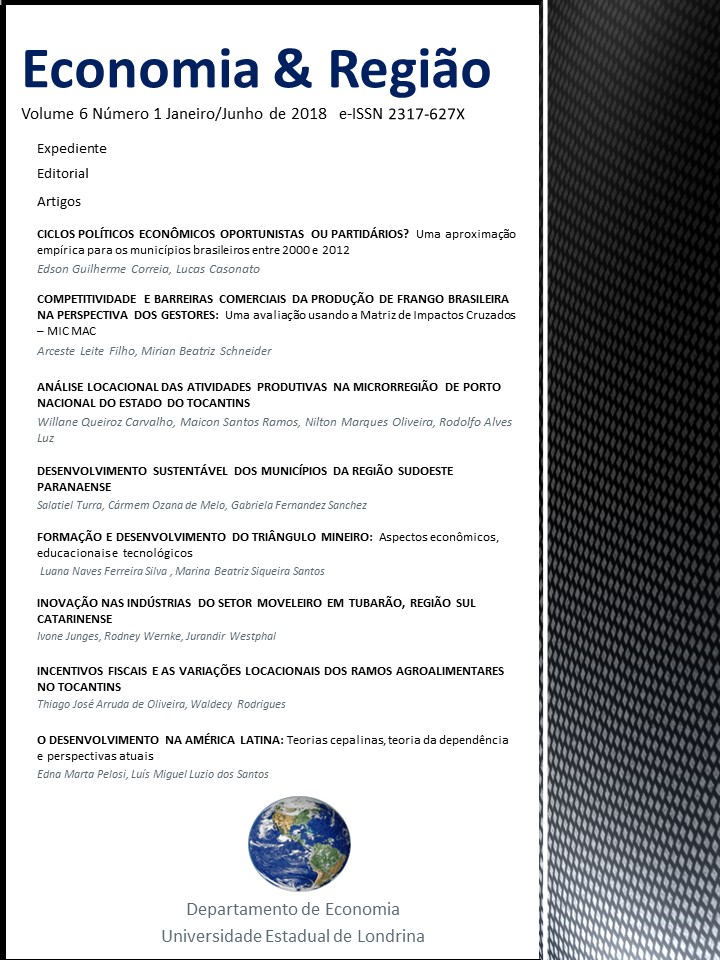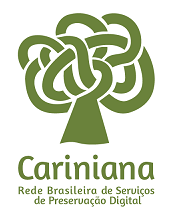Innovation in furniture industries in Tubarão, southern region of Santa Catarina
DOI:
https://doi.org/10.5433/2317-627X.2018v6n1p107Keywords:
Innovation, Competitiveness, Furniture IndustryAbstract
Innovation is a continuous process, adequate to the tendencies, intensity and typology, depending of the sector of performance, competences and entrepreneurial culture, especially small companies, focus of this study, which objective is to analyze the level of modernity and innovation in the manufacture process and management in industries of custom-made furniture sector in Tubarão. The research is a qualitative - quantitative study, realized in 21 companies of 120 companies in the custom-made furniture sector, among formal and informal, in the region of Tubarão, Santa Catarina, in the year of 2012. The data analyze considered the statements of interviewed, companies' documents, descript of routines and workflow in different organizational subsystems (functions). The data identified unprepared companies, traditionalist in management terms, values in the culture that do not generate a modern management. In the statements were highlighted that the fear perpetuates in the companies' culture, preventing the marketing expansion. The culture presented as an innovation barrier, followed by the difficult in the specialized workforce. The sector one of the foundations of the growth of the region and follow national tendency, with emphasis to the incremental innovation and design, strong growth and fierce competition.Downloads
References
BARBIERI, J. C. Sistemas tecnológicos alternativos. Revista de Administração de Empresas. Rio de Janeiro: v. 29, n. 1, p.35-45, jan./mar. 1989.
BOTELHO, M. R. A.; CARRIJO, M. C.; KAMASAKI, G. Y. Inovações, pequenas empresas e interações com o intuito de ensino/Pesquisa em Arranjos Produtivos Locais do Setor de Tecnologia Avançada. Revista Brasileira de Inovação, Rio de Janeiro (RJ), v.6 , n.2, p. 331-371, julho/dezembro de 2007.
BURLAMAQUI, L.; PROENÇA, A. Inovação, recursos e comprometimento: em direção a uma teoria estratégica da firma. Revista Brasileira de Inovação, São Paulo, n.1, v.2 p. 79-110, jan/jun., 2003.
CASSIOLATO, J. E.; LASTRES, H. M. M. Globalização e inovação localizada: experiências de sistemas locais do Mercosul. Brasília: IBICT/MCT. UFRN/CT/DEPT. Campus Universitário. Natal, RN, 1999.
CHANDY, R. K.; TELLIS, G. J. Organizing for radical product innovation: the overlooked role of willingness to cannibalize. Journal of Marketing Research, v.35, n.4, 474-487, November, 1998.
CHANDLER, A. D. Strategy and structure: chapters in the history of industrial enterprise, Cambridge, MA: MIT Press, 1962.
COOPER, C. L.; DEWE, P.; O'DRISCOLL, M. Organizational stress. A review and critique of theory, research and applications. London: Sage, 2001.
CORAL, E.; OGLIARI, A.; ABREU, A. F. de. Gestão integrada de inovação: estratégia, organização e desenvolvimento de produtos. 1 ed. 2. Reimpr. São Paulo: Atlas, 2009.
COUTINHO, L.; FERRAZ J. Estudo da competitividade da indústria brasileira. Papirus: Rio de Janeiro, 1995.
DAVENPORT, T. H.; YOUNG, E. Process innovation: reengineering work through information. USA: Harvard Business School, 1993.
DAY, G. S. Marketing's contribution to the strategy dialogue. Journal of the Academy Marketing Science, v. 20, n. 4, p. 323-329, 1992.
FLEURY, M. T. L. A gestão de competência e a estratégia organizacional. In: FLEURY, M. T. (Coord.). As Pessoas na Organização. São Paulo: Gente, 2002.
FREEMAN, C.; SOETE, L. The economics of industrial innovation. 3. ed. The MIT Press, 1997.
FUNDAÇÃO UNIVERSIDADE EMPRESA (FUNDEUN). Metodologia de diagnóstico tecnológico. Espanha: Universidade de Alicante, 1994.
GILL, S.; WHITTLE J. Gestão da panaceia: contabilização de transitoriedade. Journal of Management Studies, v. 30, n. 2, p. 281-295, Mar. 1992.
GOVERNO DE ESTADO DE SANTA CATARINA. SANTA CATARINA. MUNICÍPIOS. Setor moveleiro. Disponível em: <http://www.sc.gov.br/conteudo/municipios>. Acesso em 28 de setembro de 2012.
GOEDERT, A. R. Redes de inovação tecnológica para pequenas e médias empresas: uma pesquisa exploratória para o setor apícola catarinense. Dissertação de Mestrado, UFSC, Florianópolis, Outubro de 1999.
HAX, A. C.; MAJLUF, N. S. The concept of strategy and strategy formation process. Interfaces, vol.18, no. 3, 1988. p. 99-109.
INSTITUTO BRASILEIRO DE GEOGRAFIA E ESTATÍSTICA. PINTEC Pesquisa de Inovação. 2002. Disponível em: < http://www.pintec.ibge.gov.br/> Acesso em: 14 de março de 2012.
INSTITUTO BRASILEIRO DE GEOGRAFIA E ESTATÍSTICA. PINTEC Pesquisa de Inovação. 2005. Disponível em: < http://www.pintec.ibge.gov.br/> Acesso em: 14 de março de 2012.
INSTITUTO BRASILEIRO DE GEOGRAFIA E ESTATÍSTICA. PINTEC Pesquisa de Inovação. 2007. Disponível em: < http://www.pintec.ibge.gov.br/> Acesso em: 14 de março de 2012.
INTERNATIONAL INSTITUTE FOR MANAGEMENT DEVELOPMENT (IMD). A benchmarking study of manufacturing practice and performance in Swiss industry. EUA: IMD, 1995.
JUNGES, I. Adaptação da metodologia de Vidossich para diagnóstico de modernização de micro e pequenas empresas industriais. 148 p. (Dissertação de Mestrado). UNIVERSIDADE FEDERAL DE SANTA CATARINA. Florianópolis: Departamento de Engenharia de Produção, 1998.
KATZ, R. L. Cases and concepts in corporate strategy. Prentice-Hall Inc., New Jersey, 1970.
KRUGLIANSKAS, I. Como inovar e sobreviver em mercados globalizados. São Paulo: Instituto de Estudos Gerenciais e Editora, 1996.
LINS, H. N. Aprendizagem e inovação em uma área de produção confeccionista no sul do Brasil. In: Tecnologia e Inovação: Experiências de gestão na micro e pequena empresa. (Org. Roberto Sbragia, Eva Stal.) São Paulo: PGT/USP, 2002.
LOPER, A. A. Determinação da orientação estratégica no polo moveleiro do alto vale do Rio Negro-SC pela aplicação de métodos de análises multivariada. (Dissertação). Curitiba, 2007. Universidade Federal do Paraná. Programa de Pós-Graduação em Engenharia Florestal. Mestrado em Engenharia Florestal. p. 116.
MALDANER, L. F. O sistema nacional de inovação: um estudo comparando Brasil x Coréia do Sul. (Dissertação). São Leopoldo, 2004. Universidade do Vale do Rio dos Sinos. Programa de Pós-Graduação em Administração. Mestrado em Administração. p. 207.
MANUAL DE OSLO. Proposta para diretrizes de coleta e interpretação de dados de inovação tecnológica. Paris: OCDE Publications, 2005.
MATTOS, J. R. L. Gestão da tecnologia e inovação. São Paulo: Saraiva, 2008.
MÓVEIS ESPAÇO & LAZER. O que acontece no setor moveleiro. Disponível em: <https://sites.google.com/site/moveisespacoelazer/o-que-acontece-no-setor-moveleiro>
Acesso: 25 de julho de 2013.
NANAHAPIET, J.; GHOSHAL, S. Social capital, intellectual capital and organizational advantage. Academy of Management Review, v.23, n.2, p.242-266, 1998.
NICOLAU, I. O conceito de estratégia. Instituto para o desenvolvimento da gestão empresarial. INDEG/ISCTE. Campo Grande. Setembro, 2001.
ORGANIZAÇÃO PARA A COOPERAÇÃO E O DESEVOLVIMENTO ECONÔMICO. Dynamisin national innovation systems. Paris: OCDE Publications, 2005.
PORTER, M. E. A vantagem competitiva das nações. Rio de Janeiro: Campus, 1998.
ROCHA, A. C.; CAMARGO, C. R.; KNEIPP, J. M; ÁVILA, L. V.; Gomes, C. M.; MADRUGA, L. R. R. G. Estratégias sustentáveis e desempenho exportador no setor moveleiro paranaense. Revista de Administração FACES Journal. Vol. 12 n. 3, p.10-27, jul-set.2013.
ROGERS, E.; SHOEMAKER, F. F. Communication of innovations: a cross cultural approach. New York: Free Press, 1971.
ROGERS, E. M. Diffusion of Innovations. 4. ed. New York: The Free Press, 1995.
SBRAGIA, R. Aprendizagem e inovação em uma área de produção confeccionista no sul do Brasil. In: Tecnologia e Inovação: Experiências de gestão na micro e pequena empresa. (Org. Roberto Sbragia, Eva Stal.) São Paulo: PGT/USP, 2002.
SCHUMPETER, J. A. The theory of economic development. EUA: Oxford University Press, 1934.
SILVA, E. L.; MENEZES, E. M. Metodologia de pesquisa e elaboração de dissertação. 4. ed. Florianópolis: LED, 2005.
SILVA NÉTO, A. T.; MEIRA TEIXEIRA, R. Inovação de Micro e Pequenas Empresas: Mensuração do Grau de Inovação de Empresas Participantes do Projeto Agentes Locais de Inovação. Brazilian Business Review (Portuguese edition), v. 11, n. 4, p1-29, jul/ago. 2014.
SILVEIRA, R. I. M.; MARTINS, R. S.; LOPES, A. L. M. ALVES, A. F. Antecedents of the productive efficiency in manufacturing: experiences from Brazilian furniture industry. Revista de Ciências da Administração, Florianópolis, v.15, n.37, p.154-169, Dec 2013.
SOUZA-PINTO, H.; OLIVEIRA, M. R. G.; SOUTO, K. B.; OLIVEIRA, T. B. P.; M. M. C. O grau de inovação em diferentes setores da economia: uma abordagem a partir do Grau de Inovação Setorial (GIS). Exacta, São Paulo, v. 13, n. 2, p155-166, 2015.
TIDD, J.; BESSANT, J.; PAVITT, K. Managing innovation: integrating technological, market and organizational change. 2. ed. England: John Wiley & Sons Ltd, 2001.
TIGRE, P. B. Gestão da inovação: a economia da tecnologia no Brasil. Rio de Janeiro: Elsevier, 2009.
TORNATZKY, L. G.; FLEISCHER, M. The process of technological innovation. Lexington Boocks. Industrial Technology Institute, 1990.
VAN DE VEN, A. H. Suggestions for studying strategic process: a research note. Strategic Managment Journal. v. 13, Special issue: Strategy Process: Managing Corporate Self Renewal, p. 169 - 191, [S.l.] Summer, 1992.
VAN DE VEN, A. H.; ANGLE, H. L.; POOLE, M. S. Research on the Management of Innovation: the Minnesota studies. Oxford, New York, 2000.
VAN DE VEN, A. H.; POLLEY, D. GARUD, R.; VENKATARAMAN, S. The innovation journey. Oxford, New York, 1999.
VICO MAÑAS, A. Gestão de tecnologia e inovação. São Paulo: Érica, 2001.
WOODRUFF, R. B. Customer value: the next source for competitive advantage. Journal of the Academy of Marketing Science, v. 25, n. 2. p. 139 - 153, 1997.
Downloads
Published
How to Cite
Issue
Section
License
Copyright (c) 2018 Economia & Região

This work is licensed under a Creative Commons Attribution 4.0 International License.
Economia & Região adota a Licença Creative Commons Attribution CC-BY 4.0 International, portanto, os direitos autorais relativos aos artigos publicados são do(s) autor(es), que cedem à Revista Economia & Região o direito de exclusividade de primeira publicação.
Sob essa licença é possível: Compartilhar - copiar e redistribuir o material em qualquer suporte ou formato. Adaptar - remixar, transformar, e criar a partir do material, atribuindo o devido crédito e prover um link para a licença e indicar se mudanças foram feitas.




















